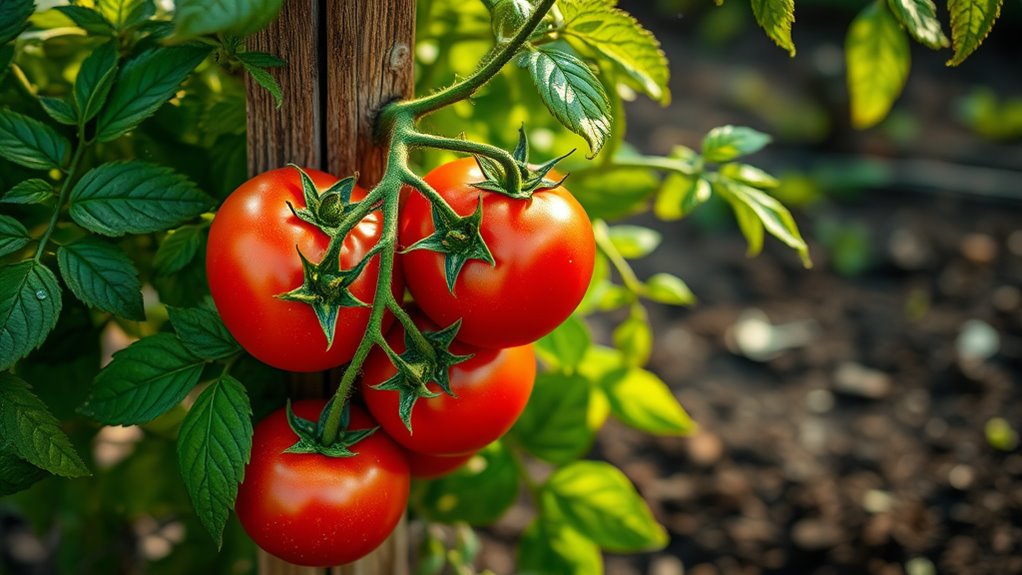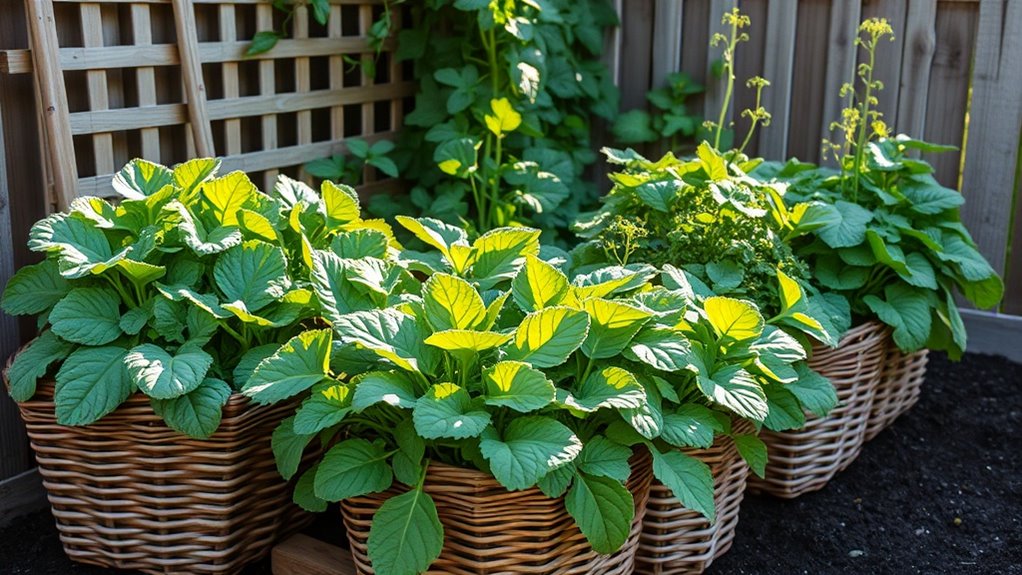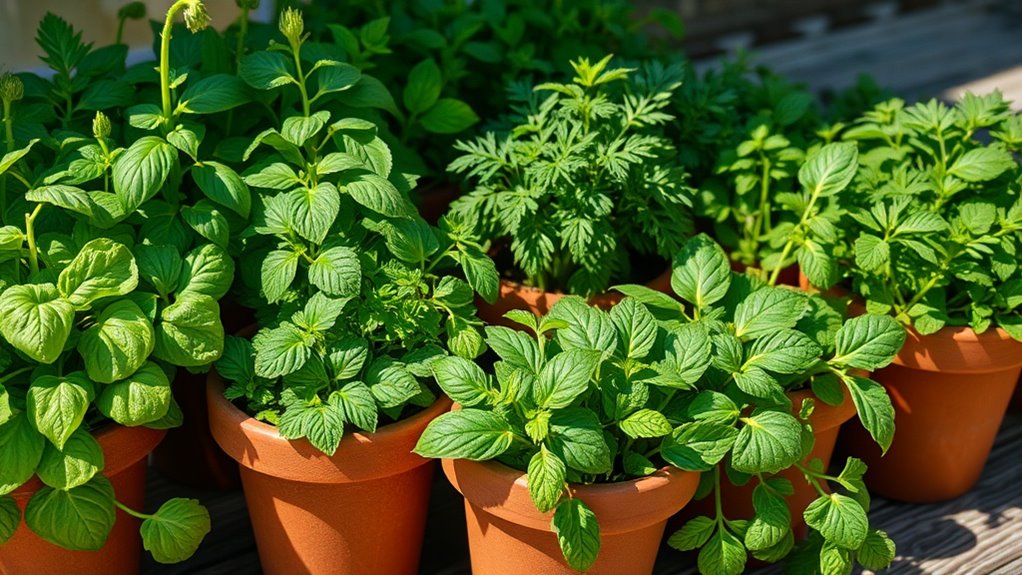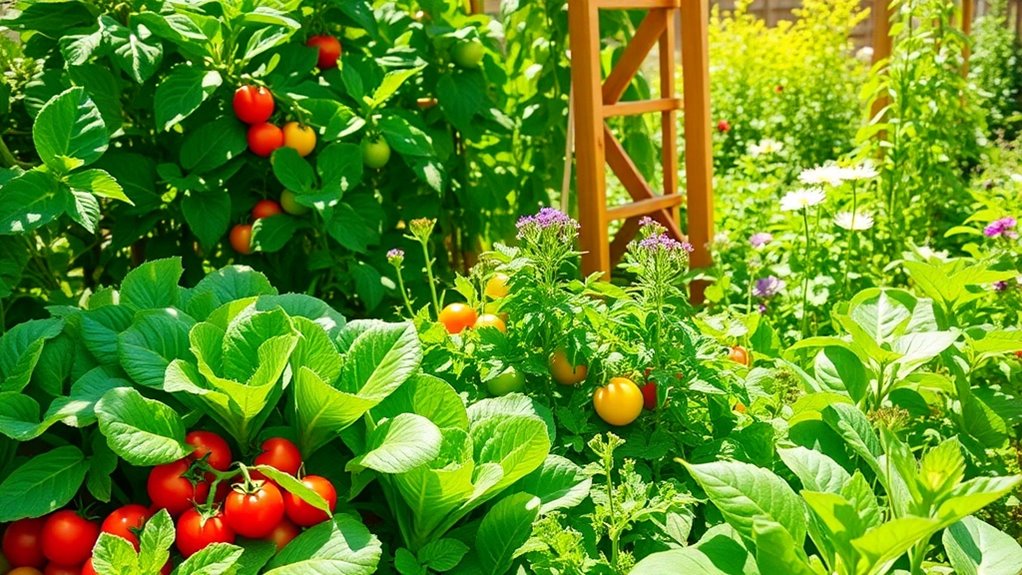The Easiest Way to Grow Tomatoes That Actually Taste Good
If you want to grow tomatoes that truly stand out in flavor, it’s crucial to start with the right varieties suited to your climate. Many gardeners overlook this step, but it can make all the difference. Next, properly preparing your soil sets the foundation for healthy growth. Curious about the best techniques for watering and fertilization? Understanding these components can elevate your gardening experience significantly. Let’s explore how to optimize each aspect for delicious results.
Key Takeaways
- Choose heirloom tomato varieties for superior flavor, keeping in mind they require more care than hybrids.
- Ensure soil pH is between 6.0 and 6.8 and amend with compost for optimal growth.
- Water deeply and consistently, adjusting frequency based on weather conditions to maintain soil moisture.
- Use organic fertilizers to enrich soil and switch to phosphorus-rich options when flowers appear for better fruit quality.
- Regularly inspect for pests and diseases, using companion planting and natural remedies to protect your plants.
Choosing the Right Tomato Varieties
When it comes to growing tasty tomatoes, selecting the right varieties can make all the difference in flavor and yield.
Start by considering your climate; some varieties thrive in warmer conditions while others prefer cooler temperatures.
Heirloom varieties often offer superior flavor but may require more care.
Determinate tomatoes grow to a set height and produce fruit all at once, which is great for canning.
In contrast, indeterminate types continue growing and yield over a longer period.
Think about your culinary needs—slicing, sauce-making, or snacking—and choose accordingly.
This thoughtful selection process will help you grow tomatoes that truly satisfy your taste buds. Additionally, proper soil preparation is crucial for enhancing the flavor profile of your tomatoes.
Preparing the Soil for Optimal Growth
To ensure your tomato plants thrive, it’s crucial to prepare the soil properly, as healthy soil lays the foundation for robust growth.
Start by testing the soil’s pH; tomatoes prefer a slightly acidic range of 6.0 to 6.8. If you find that the soil is too acidic, look for signs of acidic soil to understand its impact on plant health.
Amend the soil with organic matter like compost or well-rotted manure to enhance fertility and drainage.
Tilling the soil to a depth of 12 inches allows roots to penetrate easily.
Remove rocks and debris to provide a clean environment.
Finally, consider adding a slow-release fertilizer to boost nutrient levels, ensuring your tomatoes receive the essential elements they need for optimal growth.
Essential Watering Techniques
How often should you water your tomato plants to keep them thriving? Generally, you should water them deeply once a week, ensuring the soil stays consistently moist but not soggy. Here’s a quick reference to help you gauge your watering needs:
| Weather Condition | Watering Frequency | Soil Check Method |
|---|---|---|
| Sunny & Hot | Every 3-4 days | 2-inch soil check |
| Mild & Cloudy | Once a week | 2-inch soil check |
| Rainy | As needed | 2-inch soil check |
| Humid | Every 5-7 days | 2-inch soil check |
Keep an eye on your plants, adjusting as necessary! To maximize juiciness, ensure your watering practices promote soil conditions that enhance fruit flavor and texture.
Effective Fertilization Strategies
When it comes to fertilizing your tomatoes, choosing organic options can significantly enhance flavor and health. You’ll want to pay close attention to the timing of your fertilization to ensure your plants receive nutrients when they need them most. Incorporating a DIY fertilizer recipe can provide your tomatoes with essential nutrients while promoting sustainable gardening practices.
Organic Fertilizer Benefits
What makes organic fertilizer a superior choice for growing flavorful tomatoes?
First, it enriches the soil with essential nutrients like nitrogen, phosphorus, and potassium, promoting healthy plant growth.
Unlike synthetic options, organic fertilizers improve soil structure and enhance beneficial microbial activity, leading to better nutrient absorption.
You’ll also find that organic fertilizers release nutrients gradually, preventing nutrient burn and ensuring your tomatoes receive a steady supply throughout the growing season.
Additionally, they contribute to a more balanced ecosystem, fostering resilience against pests and diseases.
Timing for Fertilization
While the right nutrients are crucial for growing delicious tomatoes, timing your fertilization can make all the difference.
Start by applying a balanced fertilizer when you plant your seedlings, ensuring they’ve the necessary nutrients to establish strong roots.
As your plants begin to flower, switch to a fertilizer higher in phosphorus to promote fruit development.
Remember to fertilize every four to six weeks, but avoid over-fertilizing, which can lead to lush foliage at the expense of fruit.
Monitor your plants closely; if they show signs of nutrient deficiency, adjust your fertilization schedule accordingly to maintain optimal growth and flavor.
Pest and Disease Management
How can you ensure your tomatoes thrive amidst threats from pests and diseases? Start by regularly inspecting your plants for signs of trouble. Use companion planting to deter pests and encourage beneficial insects. Implementing crop rotation can also reduce disease risk. Additionally, consider incorporating companion planting strategies to enhance the resilience of your plants against common threats.
| Pest/Disease | Management Strategy |
|---|---|
| Aphids | Introduce ladybugs |
| Blight | Rotate crops, prune foliage |
| Whiteflies | Use insecticidal soap |
Harvesting for Maximum Flavor
To truly enjoy the flavor of your homegrown tomatoes, you need to pay attention to when you harvest them.
Picking at the right time ensures optimal sweetness and juiciness, while using proper techniques prevents damage to the fruit and plant. Additionally, picking at the right time can help avoid common mistakes that lead to bland or underdeveloped fruit.
Let’s explore how to determine the perfect moment for harvesting and the best methods to do so efficiently.
Timing for Harvesting
When’s the right moment to pick your tomatoes for the best flavor? Timing is crucial. Aim for harvest when your tomatoes reach full color and feel slightly soft to the touch. This ensures maximum sweetness and depth of flavor.
| Color | Feel |
|---|---|
| Bright Red | Slightly Soft |
| Orange | Firm but Yielding |
| Yellow | Firm |
| Green (mature) | Hard, not ripe yet |
Consider these indicators carefully. Picking too early can lead to bland taste, while waiting too long might compromise texture. Happy harvesting!
Best Harvesting Techniques
Choosing the right harvesting technique can significantly enhance the flavor of your tomatoes.
First, pick tomatoes early in the morning when temperatures are cooler; this helps preserve their sugars. Gently twist or cut the stem rather than pulling, which minimizes damage. Harvest when the fruit is fully colored, as underripe tomatoes lack flavor. Consider using a basket instead of a bag to avoid bruising. Lastly, avoid washing them until you’re ready to eat, as moisture can lead to spoilage.





